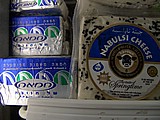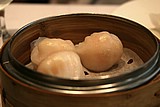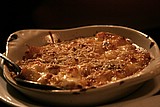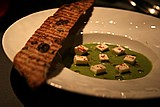Home |
Restaurants by City
|
Food Photography |
Archive | Philosophy |
![]()
Right now we are eating in Seattle, Washington.
|
Wednesday
2005
Permalink
|
Aladdin Mediterranean Market & Deli, San Mateo, Ca, tasted on April 3, 2004 I try not to make this blog about politics. And given that a healthy love of food crosses political boundaries that's usually a pretty simple task. But a visit to a small middle eastern deli in a small strip mall in San Mateo, CA touched me in a totally unexpected way. For some context I should state my position on one of the most difficult and intractable problems on the planet - the Israeli-Palestinian conflict. Without commenting on all the injustices suffered by both peoples (at each others and especially third parties' hands) I'll say that each deserve their own sovereign homeland. Israel deserves safe and secure borders, and the Palestinians deserve their own country. And every Palestinian and Israel deserve a happy and safe life. Somehow, this small market gave me a glimpse of how good a future filled with peace could be. Some background. Jews as a people have an interesting culinary heritage. Because the Jews haven't lived in any single place for hundreds or thousands of years, they have adopted the food traditions of the countries they lived in for centuries. The various Jewish cuisines much more closely resemble that of their adopted countries than they do each other. So it's no surprise that Israeli food often resembles that of the surrounding Arab cultures and countries. And this means that for me, an American Jew of Eastern European descent with plenty of experience living in Israel that my cultural cuisine is a mix of traditional Eastern European Jewish dishes and Israeli dishes that come pretty close to typical (and delicious) Arab food. But markets in the United States simply don't break across these lines. You either have:
The last category pisses me off the most as it represents this benign ignorance where the people who stock supermarket shelves think Jews eat gefilte fish 365 days a year. (Not that there's anything wrong with good gefilte fish.) So imagine my surprise when I walked into the Aladdin Mediterranean Market & Deli and found one of the best selections of Israeli food products in the U.S. being offered right next to food from Syria and Jordan in a market run by a Greek Orthodox Palestinian family from Jericho and Jerusalem. The food selections also included Greek, Turkish, Armenian, and Persian items. Hilda and George Khoury run the Aladdin Market and it's clear that their small shop is a labor of love and practicality. All day customers of all backgrounds, Jews, Arabs, everybody stream through the door to pick up their specialty food items. And many greet the Khourys warmly. It feels to me like some people hang out at the market for longer than they need to just buy their produce or dairy products. As soon as I expressed interest, Hilda took me under her wing and started giving me the tour as well as having me sample some of the delicacies they were offering. There was Greek Easter bread with Cardamom. Turkish Tabouleh homemade by Hilda which included tomato paste and was a little spicy. Homemade yummy spinach pies were in a stack waiting to be eaten. The pastry tasted of lemon juice, spinach , onions, and a healthy does of olive oil. The shawarma was made from boneless chicken thighs and breasts marinated for 24 hours then stacked. It was not pressed meat Hilda proudly pointed out. I think I ate two of them. Mujadala - lentils and rice. Bastirma- Armenian cured beef. The closest I can come to describing it was that it tasted paprika-ish even though I knew it wasn't paprika giving it the flavor. It was however, fantastic and savory. Two sizes of falafel... of course! Muhamara from Alepo - Turkish peppers with walnuts. Hilda makes excellent Kubeh - bulgur wheat dough wrapped around ground beef with pine nuts. And finally, more feta cheese than you can shake a stick at. Israeli, Turkish, Greek, Bulgarian, and French feta to be exact. The French was creamy, while the Bulgarian was very tangy and more crumbly. The Israeli feta was super salty and unique. The bins of warm nuts staying fresh and giving off their comforting aroma also reminded me of time in Israel where this is a common site. Cashews, pumpkin seeds, sunflower seeds, and more filled the bins. I hung out for awhile in the Aladdin market. Hilda made me feel at home, and it didn't hurt that I kept buying more food to take home as well as trying more creations that Hilda was proud of. They were all delicious. At one point I was asking about her background and she told me that from 1948 - 1967 they lived in Jerusalem, in Jordan. She let her words trail off. The implications for anyone who understands the history of the area is that in 1967 after the Six-Day-War, Hilda's family lost their home. In terms of sensitive subjects, losing one's home during a war pretty much ranks at or near the top, especially when it's clear that the person you're talking to is a supporter of the country that exists where that home used to be. And yet, when I asked Hilda how she and her husband George (who didn't seem too into my curiosity but was friendly nonetheless) decided to stock such a broad range of products that crossed political, religious, and cultural boundaries, she responded simply "we all live together over there. I wish everyone could get along like they do here." And there it was. I think for the Khourys It's good food and good business.I know it sounds corny, but as I chatted with an Arab-American customer about the merits of the various pita breads for sale, and I noticed the Israeli and Syrian cans of olives sitting peacefully next to each other on the shelf, as well as the Arab cheese side-by-side with the Israeli butter, I thought to myself - wouldn't it be great if everyone really could get along? Imagine the meals we could all have. :)
|
|||
Our Sponsors
Free Car Listings Hot Tubs Stools Saunas Bar Stools - Calendar and Event Schedules - Food Events and Calendars - Wine Events and Calendars - Digital Photography Resources - Software for Advertisers - Jewish Gifts and Judaica - Howard Stern Podcast - ponytailed blogger Jonathan Schwartz

Browse tastingmenu
Home |
Restaurants by City X |
Food Photography |
Archive | Philosophy |
![]()
Free eBooks: All About Apples
| Autumn Omakase
More:
Discussion |
Cool Food T-Shirts |
Ingredients
| Markets |
Recipes
Search |
Blog FAQ |
Other
Blogs
Best of tastingmenu
|
City View
Entry: July 6, 2006 |
Blue Plate
Entry: June 19, 2006 |
L'Atelier de Joël Robuchon
Entry: July 18, 2006 |
Browse by City
Boston | Chicago | Houston | Las Vegas | Los Angeles | Maui | New York | Philadelphia | Portland | San Francisco | Seattle | Toronto | Utah | Vancouver | Washington D.C.
Bangkok | Beijing | Hong Kong | Seoul | Tokyo
Amsterdam | Berlin | Italy | London | Madrid | Paris | Vienna
Browse by Month
2006
2005
2004
2003
2002
2001
Comments, questions, or feedback:
info / at / tastingmenu / dot / com
All pages Copyright (c) 2001-2006 tastingmenu.com
Last modified 01/30/07.




